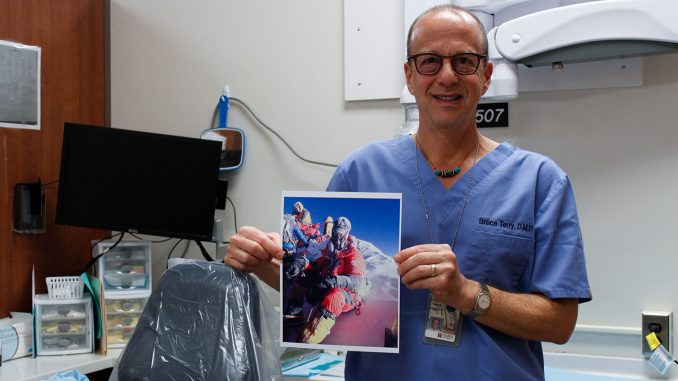
In 2004, Bruce Terry’s wife handed him a magazine article about a man with little climbing experience who scaled Mount Rainier in Washington.
“She said, ‘Happy birthday, go do this. It sounds like it’s miserable.’ So I took her up on the challenge,” said Terry, a 1986 alumnus of Temple University’s Kornberg School of Dentistry and current assistant clinical professor of endodontics.
At the time, his wife Susan Scanlon had no idea that she sparked a new passion within her husband: to scale the seven highest mountains on Earth.
Terry completed this goal when he reached the summit of Mount Everest in the early morning on May 23. He assumes himself to be the first dentist to summit the seven peaks, an unofficial climbing joke among his colleagues and climbing friends.
Terry said that when he started climbing, his wife and children didn’t want him to climb Everest because of possible lack of oxygen, inclement weather and avalanches.
“After I had gotten about four or five of the seven summits under my belt, all of the sudden the tone started to change in my family [to], ‘so are you going to do Everest?’” he said.
Terry’s climbing group met in Kathmandu, Nepal, in late March. From there, the group was flown to Lukla, a small town in northern Nepal, where they began the climb for Everest Base Camp. The base camp trek takes climbers through the scenic Khumbu Valley, ultimately taking about 10 days to hike from 9,000 feet to 18,000 feet, Terry added.
When scaling Everest, climbers split the trek into one to three-day trips, called upper mountain rotations, to acclimate to altitude changes. Between the rotations, they stayed at four different camps stationed on the mountain, many of which Terry said he took through the Khumbu Icefall.
“Getting to Everest base camp for me was like a child getting to Disneyland,” Terry said.
Every May, the sherpa, or mountain guides, fix the ropes leading to Mount Everest so climbers can summit. The climbers then wait at base camp for a weather report that shows clear conditions for about five to six days.
This year, Terry said there were only two clear days of weather, which created a “traffic jam” on the mountain. Luckily, Terry’s group, which had people from 10 different countries, trekked during the night, so they ran into very little traffic going up the mountain.
Terry’s immediate group started the climb at 7.30 p.m. and reached the summit at 5.30 a.m.
“It a very surreal experience, for 10 hours you’re just climbing in the night and all you see are headlamps and everyone is silent,” Terry said. “It’s just very eerie.”
Terry’s family tracked his movement via satellite, through a device called Garmin in reach, while he summited.
“I became a nervous wreck,” Scanlon said. “I started just refreshing the screen to see if the little blue dot that was [Terry] had moved at all. We saw he hit the top and made it to the summit, and we were all very excited and very relieved.”
Brady O’Mara, a physical therapist at Seven Summits Therapy and Fitness, is Terry’s best friend and training partner of 12 years. The two met while training for different climbs in Valley Forge Park, Pennsylvania, and later climbed Mount Elbrus in Russia and Denali in Alaska together.
“Everybody was pulling for him [to summit Everest] but I knew a lot more of the ups and downs, physically and psychologically that you go through on the mountain,” O’Mara said. “Bottom line is that I’m proud of him and excited he achieved his goal.”
O’Mara typically climbs with people from all over the world, but it was nice to climb with a familiar face, he said.
Terry said he’s not sure what his next goal will be. As a self-described “type-A, goal-oriented person without a goal,” he has to find another mountain to climb soon, Terry said.
“Everest is definitely going to be one for the books, for everything about it. It was just such a long adventure that holds so many memories because there are so many different parts of it.”


Be the first to comment